Introduction

Evolutionary Principle
The name ‘Matrimandir’ means literally ‘Temple of the Mother’. According to Sri Aurobindo’s teaching, the ‘Mother’ concept stands for the great evolutionary, conscious and intelligent principle of Life, the Universal Mother, – which seeks to help humanity move beyond its present limitations into the next step of its evolutionary adventure, the supramental consciousness.
At the very centre of Auroville one finds the ‘soul of the city’, the Matrimandir, situated in a large open area called ‘Peace’, from where the future township will radiate outwards. The atmosphere is quiet and charged, and the area beautiful, even though at present large parts of it are still under construction.
As yet incomplete, the Matrimandir emerges as a large golden sphere which seems to be rising out of the earth, symbolizing the birth of a new consciousness seeking to manifest. Its slow and steady progress towards completion is followed by many.
The Principal Architect
Roger ANGER Architect. Roger Anger has executed more that forty major projects in France and abroad and has been rewarded with several prizes. Currently he is particularly interested in town-planning issues and has been charged by the Indian government to design commercial centers and cities linked to industrial complexes. Since 1986, he is engaged in the conception and realization of the project of Auroville, an experimental city in the south of India, where he is currently completing the world-renowned meditation structure known as the Matrimandir.
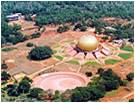
Roger Anger, who had received the Mother’s instructions regarding this aspect of Matrimandir, has worked out the technical details: The diffuse sunlight behind the golden disks should shine through the 800 portholes in the ferrocement skin, illuminating 800 translucent orange-pink triangles, which form the Matrimandir’s Inner Skin. Although the shape and size of these translucent triangles is determined by the triangular beam structure, the beams and portholes should not be visible through the Inner Skin. The whole inside of Matrimandir should be filled with this orange-pink glow, coming from all sides, and no design-element or detail behind the orange screen should disturb the peaceful impression.
Symbolism
The Matrimandir wants to be the symbol of the Universal Mother according to Sri Aurobindo’s teaching.
Inner Chamber
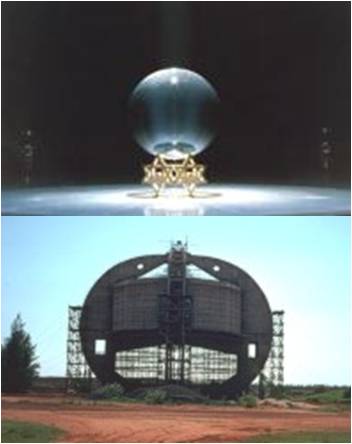
The spacious Inner Chamber in the upper hemisphere of the structure is completely white, with white marble walls and white carpeting. In the centre a pure crystal-glass globe suffuses a ray of electronically guided sunlight which falls on it through an opening at the apex of the sphere The four pillars that support the structure of Matrimandir, and carry the Inner Chamber, have been set at the four main directions of the compass.
Maheshwari (South Pillar)
One is her personality of calm wideness and comprehending wisdom and tranquil benignity and inexhaustible compassion and sovereign and surpassing majesty and all-ruling greatness.
Mahakali (North Pillar)
Another embodies her power of splendid strength and irresistible passion, her warrior mood, her overwhelming will, her impetuous swiftness and world-shaking force.
Mahalakshmi (East Pillar)
A third is vivid and sweet and wonderful with her deep secret of beauty and harmony and fine rhythm, her intricate and subtle opulence, her compelling attraction and captivating grace.
Mahasaraswati (West Pillar)
The fourth is equipped with her close and profound capacity of intimate knowledge and careful flawless work and quiet and exact perfection in all things.
The Mother’s Symbol and the Petals
The meditation rooms inside the twelve stone-clad ‘petals’ surrounding the Matrimandir carry the names and colours of the ‘petals’ in the Mother’s symbol:
These are:
Colours of Meditation Rooms
The above mentioned names and colours have been integrated into the sequence of the meditation rooms which are being completed inside each of the twelve petals surrounding the structure in the following order:
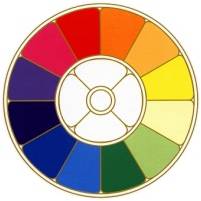
- Sincerity – light blue
- Peace – deep blue
- Equality – blue violet
- Generosity – pure violet
- Goodness – reddish violet
- Courage – red
- Progress – orange red
- Receptivity – orange
- Aspiration – orange yellow
- Perseverance – pale yellow
- Gratitude – pale green
- Humility – deep green
(When moving from the south axis towards the east axis, the Humility room is in the first petal.)
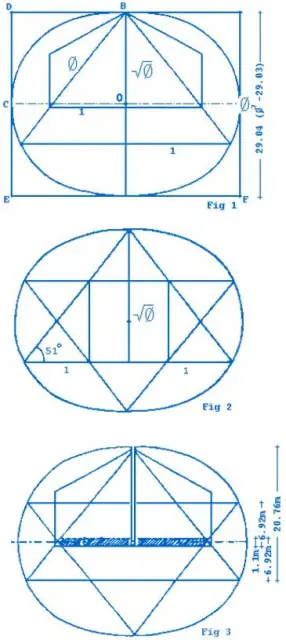
Sacred Geometry
What in terms of `architecture’ makes the Inner Chamber a special place?
It was ten years after Mother first expressed her vision of the Inner Chamber that it was found by chance that the Golden Section and the proportions of the Great Pyramid are precisely incorporated in its cross section (fig 1).
It was also discovered that Sri Aurobindo’s symbol fitted exactly into the Shalagram, the form in which Matrimandir has been built (fig.2). (A shalagram is an ancient symbol described in Hindu Cosmology as ‘the Egg of Brahman’ from where the creation has sprung forth). In other words, there are two triangles with the same proportions as the Great Pyramid inside the Shalagram
The energy field inside the Great Pyramid is located at one-third of its height (the place where the King’s Chamber is situated). If we project this to the two triangles inside the Shalagram, we get a band of about 110 centimeters where the energy field will be concentrated. This band will be in the Inner Chamber, precisely where the people will sit. fig 3.)
The Gardens
There are twelve gardens surrounding the structure, converging around it in the huge petal crown from which the Matrimandir arises. In 1969, when discussing the gardens, the Mother indicated that they would have to be of such quality and beauty that people visiting them would experience, physically and concretely, the significance of each garden:
Garden Names
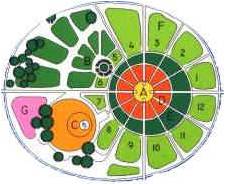
- Existence
- Consciousness
- Bliss
- Light
- Life
- Power
- Wealth
- Utility
- Progress
- Youth
- Harmony
- Perfection
A – Matrimandir
B – Garden of Unity
C – Ampritheatre
D – Rose Garden
Construction Phases
1970
It all began with a vision the Mother had in January 1970, which was taken up by Roger Anger, the French architect she chose for the project. After this, Roger presented her with various possible designs, and in 1971 the final, approved globe model for the structure was presented to the Mother and to the residents of Auroville, and work could start. The foundation stone was laid on February 21st 1971, and the practical work of overseeing the engineering requirements for the construction was given to the Aurovilian architect/engineer Piero Cicionesi who lead the development up till the completion of the Inner Chamber.
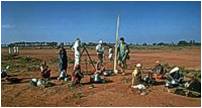
From 1971 – 1973
Excavation and Foundations
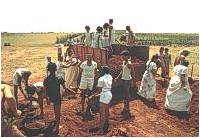
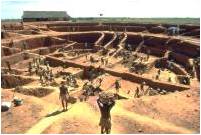
Research into the design of the structure went on simultaneously with the excavation of a ten metre deep crater at the centre of Auroville for the foundations.
Consultancy for the structural design was graciously given by Dr. T.K. Santhanam of SERC (Structural Engineering Research Centre), Chennai. The detailed construction drawings, the design and fabrication of the staging and shuttering, as well as the overall organisation and execution of the construction, were done by the Aurovilians under the guidance of Piero.
The foundation stone was laid at sunrise on 21st February 1971 – the Mother’s 93rd birthday. The excavation was started in March by Aurovilians and Ashramites, but was later taken over by a paid local work force more equal to the task. Construction of the sphere started with the erection of a steel-pipe scaffolding, anchored on the foundation. The scaffolding reached a height of ten metres to support the 400 ton weight of the first slab of the sphere. Wooden scaffolding and temporary towers for hoisting had to be erected on the four pillars. Steel mountings to hold the discs planned for covering the outer surface of the finished structure had also to be fixed in a regular pattern. Then came the concreting for the first slab, which went on without rain interruption for six days during the peak of the monsoon season. It was completed at the Western pillar summit at 7.25 p.m. on the 17th of November 1973, in perfect weather.
From 1974 – 1979
The Pillars
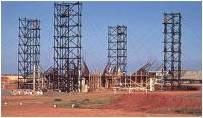
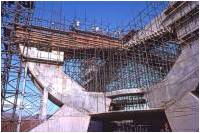
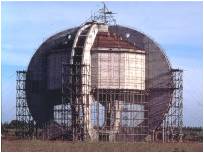
During January and February of 1974 preparations proceeded for concreting the first layers of the four pillars which would form the framework of the sphere. Casting of the second level slab was completed in March 1974. During the autumn of 1974 construction entered a new phase with work on the four pairs of cantilevered arm-brackets joining together the four rib pairs in a ring-beam at the centre; situated more than 14 metres above ground level, these brackets and this ring-beam would support the floor of the inner chamber. This beam was cast in December 1974. By the beginning of 1975 work on the ribs at all four pillars had reached the half-way point after a steady succession of concretings. By September 1975, the ribs had begun to curve inwards and upwards and preparations were underway to join the ribs in a ring beam at the top of the sphere. This beam was finally cast in a two day concreting which began on the 28th of May 1976.
At 29 metres above ground level a final ring-beam supports the roof of the interior chamber. In June 1976 the pipe scaffolding was taken down and for the first time the interior space of the Matrimandir was visible.Concreting of the floor of the Inner Chamber took place in November 1976, and the work on the walls of the Chamber began. These were poured in layers using a specially fabricated steel shuttering.Simultaneously, ramps which would join the second level to the Inner Chamber were being fabricated in sections in the Matrimandir workshop.Construction of the roof began quarter by quarter, and was cast through numerous concretings over the next two years.
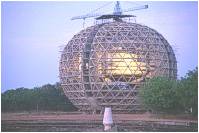
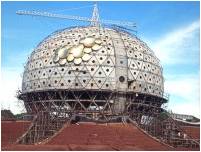
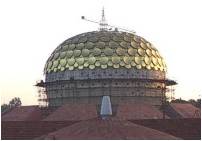 Gold Discs
Gold Discs 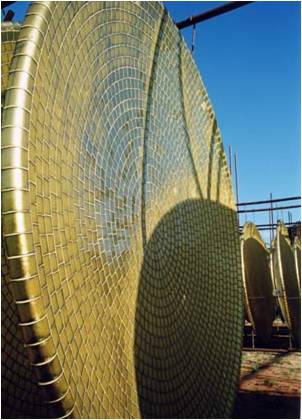
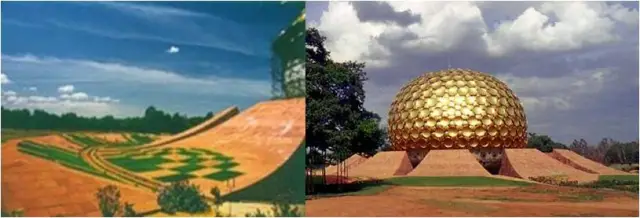
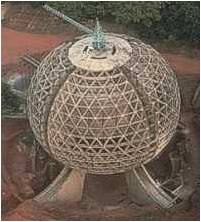 diameter, galvanised, seamless steel pipes, 8.65 mtr long, weighing 830 kg each. The painting job appeared straightforward and the first two were done completely in a couple of months. A dedicated team started putting in extra time, a few infra-red lights appeared to help the drying, and then even an electric polishing machine arrived to speed up the work. There are an average of 15 coats of paint on each column with finer and finer sanding between coats after which the final polishing was done.
diameter, galvanised, seamless steel pipes, 8.65 mtr long, weighing 830 kg each. The painting job appeared straightforward and the first two were done completely in a couple of months. A dedicated team started putting in extra time, a few infra-red lights appeared to help the drying, and then even an electric polishing machine arrived to speed up the work. There are an average of 15 coats of paint on each column with finer and finer sanding between coats after which the final polishing was done.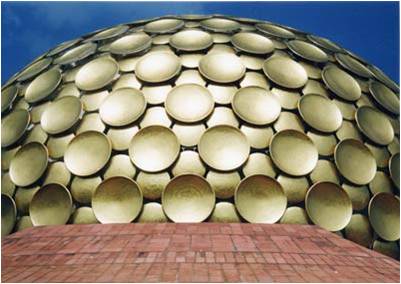
| Disc Frame | Stainless Steel Tubes |
| Disc Material | Stainless Steel Sheet |
| Gold Leaf | 28 gm of Gold per 1000 leaves |
| Leaf Size | 85×85 mm |
| Total Number of Discs | 1415 |
| Small Convex Discs | 954 |
| Large Concave Discs | 461 |
| Average Diameter (Large Discs) | 2.3 meter |
| Average Diameter (Small Discs) | 1.5 meter |
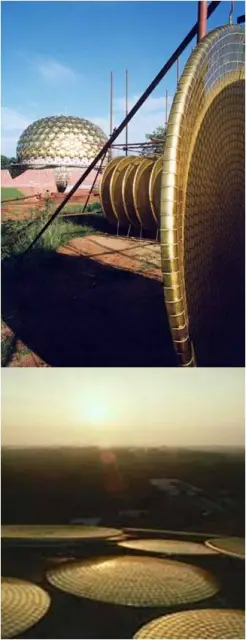
The outer skin of Matrimandir is to be totally covered by decorative, golden, concave and convex discs. Mounted onto the structure by a system of metal rods, they will have the practical function of shading the building from the strong sunlight of south-India. In August 1995 the gilding of the discs started under the guidance of a master gilder from Germany. About 461 big convex discs (2.3 m diam) and 954 small (1.4 m diam) concave discs were to be produced. Over 100 discs were made using the method of gilding which the master gilder taught the workers at Auroville, before it was discovered that this method might not be suitable. Birds and bees, attaching themselves to the gold discs forced a reconsideration of this method of gilding.
By October 1996 no doubts were left about the best solution for the golden discs. After several months of research in Asia and Europe, the method was chosen of encasing the gold leaf between two thin layers of glass, sealed at the edges, to yield something like a 4 x 4 cm gold ’tile’. It offers a solution which answers not only requirements of durability but also easy maintenance. The gold will be safe inside the glass which can be scrubbed, brushed and sprayed. Replacement of one or more of the gold tiles can also be done easily.The gold leaves are manufactured in Germany and are of a high quality (28 g of gold per 1000 leaves). About 18 kilos of gold will be required – 750,000 leaves in all, of about 85 x 85 mm and of 8 microns thick.As of December 2000, 852 golden discs have been mounted on the structure’s skin.
The Crystal Globe
The crystal for the Matrimandir arrived in Auroville on 26-4-91 at 10.15 p.m. It was moved into the Matrimandir’s Inner Chamber the very next day at 09.45 a.m.
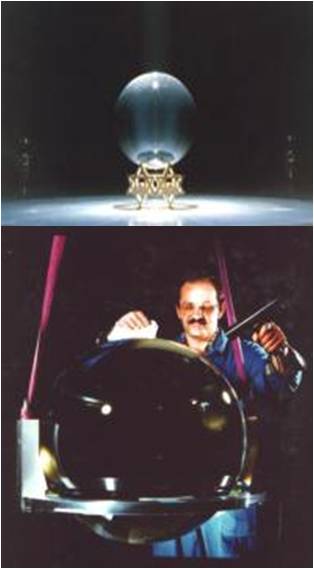
The size of 70 cm diameter was marked on the original plan that Mother had drawn for the central object in the Chamber. In July 1983, the searchlight fell on the firm of Schott in Mainz, and somewhat later on Zeiss in Oberkochen, both in Germany. These firms proposed the type of crystal – optically perfect glass – with the name of Bohr Kron 7. On the 8th of June 1984, Zeiss presented the study, and gave the estimate: approx. 230,000 German Marks. On May 12 1987, Schott wrote to Zeiss that the cast has been done, and that the mould was being cooled. When two months later a visit to Zeiss was made, it appeared that this casting was the second one, – the first one having failed for unpublished reasons.
The casting at Schott’s in Mainz lasted 15 hours, and was done in a special form of refractory stone, held together by seven metal bands, which was placed on top of a platform built of iron and steel. During the casting process the glass in the form was kept at a constant temperature. After 15 hours the rough casting in the form of a massive dome with a diameter of 80 to 85 cm and a weight of 1100 kg was finished, after which it was cooled down extremely slowly (to avoid tension) in an annealing furnace for a period of 5 weeks. The rough form had to be polished on two sides, in order to test the quality of the glass. Finally, at the beginning of 1991, it became clear that the process to deliver the globe could be started, and in April of the same year it reached its destination, the Chamber.
The seventy centimeter diameter ‘crystal’ globe, the only one of its kind, is 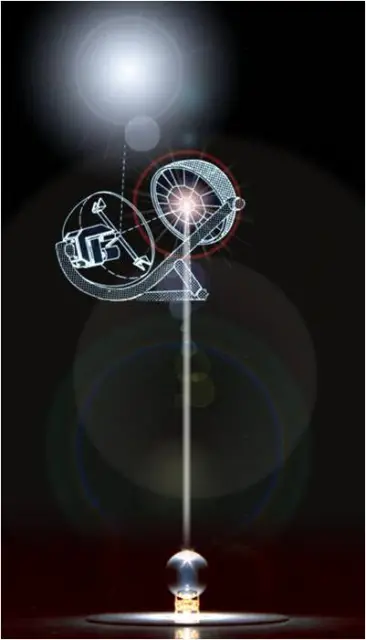 the biggest optically perfect glass globe ever made in the world. On arrival at Madras Airport in April 1991, it was passed through customs in record time and driven straight to Auroville. The next morning it was hoisted in its packing crate up to the Inner Chamber.
the biggest optically perfect glass globe ever made in the world. On arrival at Madras Airport in April 1991, it was passed through customs in record time and driven straight to Auroville. The next morning it was hoisted in its packing crate up to the Inner Chamber.
Mother said that four of Sri Aurobindo’s symbols – standing upright and joined together at the corners – should carry the crystal globe in Matrimandir. During the time that the symbols were being manufactured (between 1992 and 1993) the crystal was placed on top of a prototype of the four Sri Aurobindo symbols. In 1993 the prototype was replaced with the finished symbols
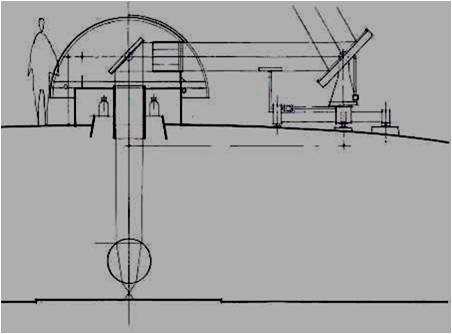

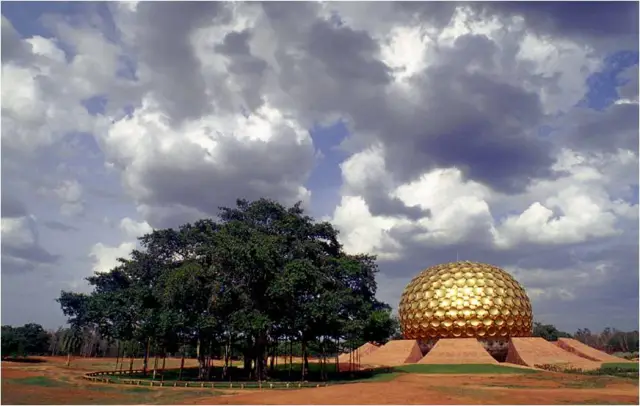
Leave a Reply
You must be logged in to post a comment.